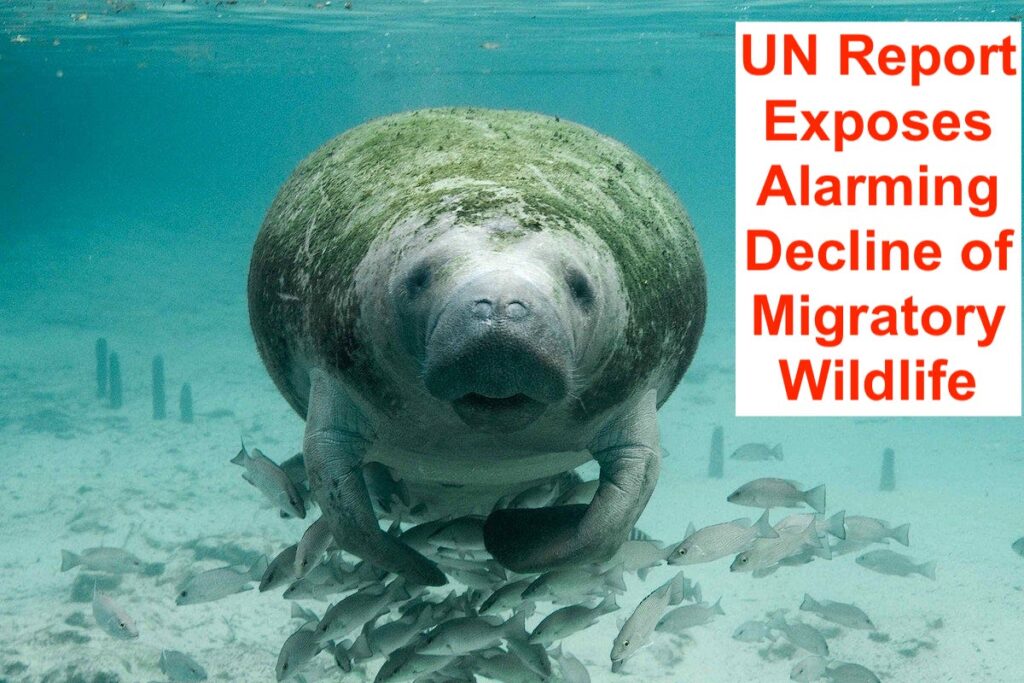UN Report Exposes Alarming Decline of Migratory Wildlife: The Convention on the Conservation of Migratory Species of Wild Animals (CMS), a UN biodiversity treaty, has released its first-ever State of the World’s Migratory Species report at the opening of a major UN wildlife conservation conference (CMS COP14).

Key Findings of State of the World’s Migratory Species Report 2024
This comprehensive analysis sheds light on the conservation status of migratory species worldwide, delineating current trends and identifying major challenges.
- Population of migratory species under CMS declines: A significant proportion, nearly half (44 percent), of CMS-listed migratory species are witnessing declines in population.
- Extinction Threat for CMS-listed species: Alarmingly, more than one-in-five (22 percent) of CMS-listed species face the danger of extinction, with a staggering 97 percent of CMS-listed fish under threat.
- Escalating Extinction Risk for migratory species globally: The risk of extinction is mounting for migratory species globally, including those not encompassed by CMS.
- Lack of Protection: Approximately half (51 percent) of Key Biodiversity Areas for CMS-listed migratory animals lack safeguarding measures, while a concerning 58 percent of monitored sites are besieged by unsustainable human-induced pressures.
Primary Threats Identified by State of the World’s Migratory Species Report 2024
- Overexploitation and Habitat Loss: Overexploitation and habitat loss, stemming primarily from human activities, emerge as the foremost threats to migratory species, affecting three out of four CMS-listed species.
- Other Pressures: Climate change, pollution, and invasive species also exert significant pressures on migratory species.
Urgent Call to Action – State of the World’s Migratory Species Report 2024
- International Cooperation: Urgent action is imperative to reverse population declines, safeguard key sites, and uphold the phenomenon of migration itself.
- Strengthened Efforts: Collaborative endeavours under CMS, such as intergovernmental task forces and multilateral initiatives, necessitate fortification and expansion.
- Addressing Gaps: Emphasis should be placed on identifying additional key sites, comprehending threats, and ensuring the efficacy of protective and conservation measures.
- Tackling Overexploitation: Further action is warranted to combat overexploitation, encompassing enhancements in legal protections and monitoring endeavours at both national and international levels.
Global Cooperation is Key says State of the World’s Migratory Species Report
- Despite lingering data gaps, solutions to mitigate population declines and species loss are discernible, underscoring the imperative for active engagement across governments, communities, and stakeholders.
- Contributions to Biodiversity Framework: Actions undertaken pursuant to CMS will not only redound to the benefit of migratory species but also contribute to fulfilling global commitments outlined in the Kunming-Montreal Global Biodiversity Framework.
Conclusion – State of the World’s Migratory Species Report
- The report underscores the imperative for concerted efforts to conserve migratory species and foster the recovery of their populations and habitats worldwide.
- Accelerated action is indispensable to confront the biodiversity crisis and safeguard the invaluable ecological contributions of migratory species.
The disclosure of the State of the World’s Migratory Species Report represents a pivotal juncture in global conservation endeavours. With populations dwindling and extinction risks intensifying, expeditious action is imperative to safeguard these pivotal species and the ecosystems they inhabit. Through augmented international cooperation and fortified conservation measures, there exists hope for reversing the disconcerting trends delineated in the report and securing a sustainable future for migratory species worldwide.
